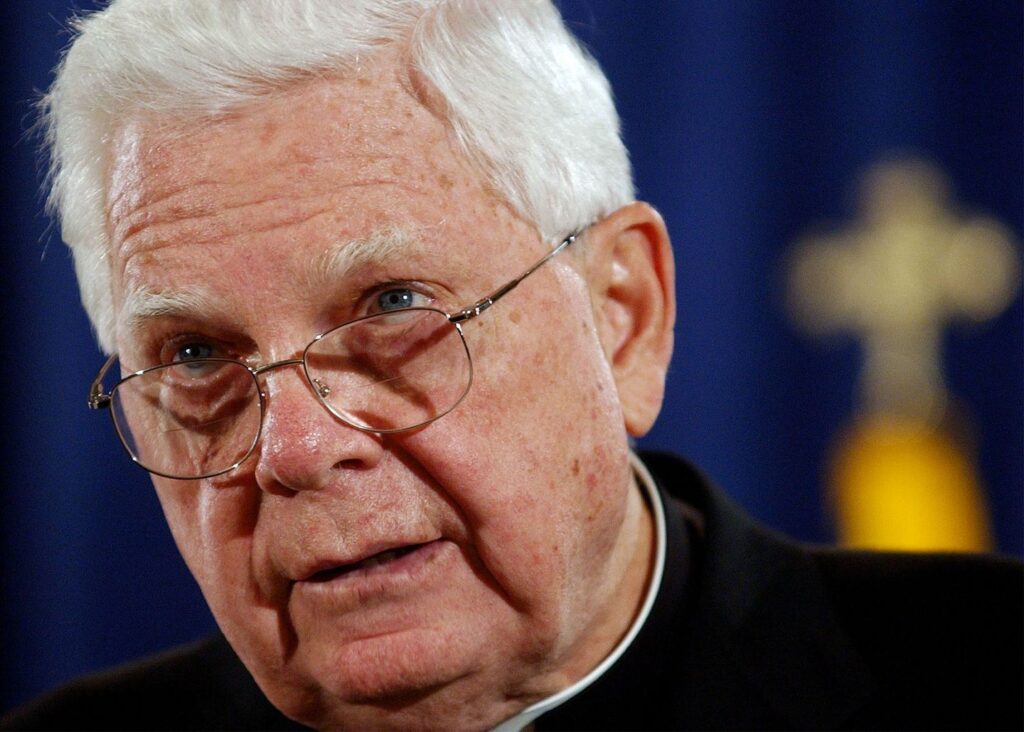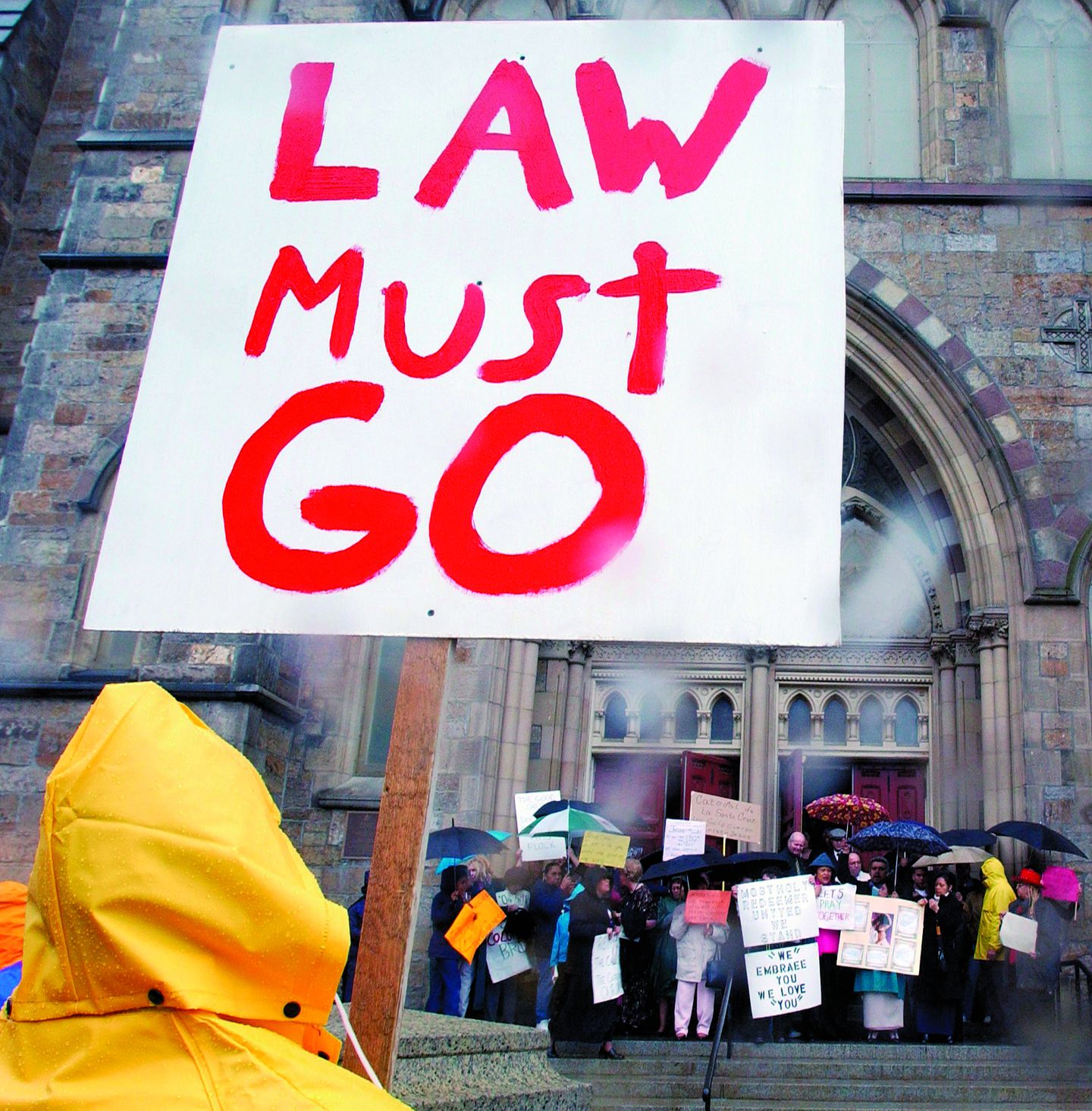BOSTON (MA)
Boston Globe
September 22, 2021
By Joseph P. Kahn and Mike Damiano
The Spotlight Team revealed the church’s secret protection of pedophile priests in a series with global repercussions.
[Photo above: A man protesting against Cardinal Bernard Law faces a group of pro-Law protesters on the steps of the Cathedral of the Holy Cross in Boston in April 2002. – Michael Dwyer/AP/File]
On his first day on the job in July 2001, Globe editor Martin Baron stopped by the desk of Eileen McNamara, a Pulitzer Prize-winning columnist. A week earlier, McNamara had published a column about the Boston Archdiocese’s silence on three priests accused of sexually abusing children. One line, in particular, had irked Baron. McNamara had wondered whether an accused priest’s superiors had known about his crimes. Court documents were sealed. “The public,” she concluded, “has no way of knowing.”
McNamara recalls Baron standing over her desk: “Why don’t we find out,” he said.
Spotlight’s investigation of sexual abuse in the Catholic Church did not begin with a tip or newly obtained document, as so many investigations do. Instead, it started when a new Globe editor spurred his newsroom to action. After telling the Globe’s senior leaders he intended to pursue the story, Baron asked Spotlight editor Walter V. Robinson to make sexual abuse by priests his team’s next project.
Robinson, a three-decade newsroom veteran, was taken aback. “Editors never told the Spotlight Team what to do,” Robinson says. “The Spotlight Team told the editor what it was going to do.” But it was clear that this wasn’t a debate. Robinson returned to Spotlight’s office and instructed his team — Michael Rezendes, Sacha Pfeiffer, and Matthew Carroll — to get to work.
The story wasn’t new to them. The Globe had been covering the abuse cases for a decade, and other outlets had been on the story for even longer. “I always remind people we didn’t reveal the existence of priest sex abuse,” Rezendes says. Rather, Spotlight set out to do what it does best: reveal the systemic problem behind the individual stories. “What we did that was new,” Rezendes continues, “was show the scale of the issue and the coverup.”
The team’s first guide was Phil Saviano, a survivor of clergy sexual abuse himself who founded an advocacy group for other survivors. That August, Saviano visited Spotlight’s office and delivered what he calls “a graduate-level seminar in clergy abuse.” During the next month, reporters carried out some of the project’s most grueling work: speaking with victims. Pfeiffer remembers middle-aged men sobbing at their kitchen tables. Rezendes met with victims and their families at the office of Boston lawyer Mitchell Garabedian. “Everyone was crying and sometimes screaming,” Rezendes recalls. “It was horrific.”
But this was a Spotlight project. Wrenching individual stories were not enough. Reporters needed to know how widespread the rot was — and how far up it reached. One valuable source was researcher Richard Sipe, a former priest himself, whose work suggested that 7 percent to 10 percent of Boston-area priests might be sexual predators. Those figures stunned the reporters. Moreover, Sipe told them, the church often quietly shuffled predator priests from one parish to another, to sidestep accusers. That tip inspired the team to comb through years of the archdiocese’s annual directories. Carroll created a database to search for hidden reassignments.
Larger questions still loomed, however. Who was shuffling these priests around? Who else knew about it? For Rezendes, the key to unlocking those mysteries was Garabedian, who suggested looking through documents filed in a lawsuit against the Rev. John Geoghan, a notorious serial pedophile. Buried in this cache was a smoking gun: a 1984 letter from Bishop John D’Arcy to Bernard Law, who would become cardinal the next year. D’Arcy criticized Geoghan’s latest reassignment and cited the priest’s “history of homosexual involvement with young boys.”
Holy shit, they knew, Rezendes thought when he read those words. They knew, and they let it happen.

On the morning of the September 11 terrorist attacks, work on the church investigation was put on hold for six weeks. By the turn of the new year, however, the first installments were ready for publication. On January 6, 2002, Geoghan’s crimes were spelled out, in sickening detail, under a front-page headline: “Church allowed abuse by priest for years.” Anticipating protests outside the building — Catholics made up a significant portion of Globe readership, and the paper and church had long had a fraught relationship over issues such as abortion — Baron had ordered up extra security.
None was needed, as it turned out. Yet, clashes between the Globe and church authorities hardly ended there. For months, Globe outside counsel Jonathan Albano had been fighting, at Baron’s direction, to unseal confidential records related to the Geoghan case. Once made public through a ruling by Superior Court Judge Constance Sweeney, victims’ lawyers, including Garabedian and Roderick MacLeish Jr., were free to share other lawsuit-related documents with Spotlight reporters. The internal church records showed coverups extending well beyond the Geoghan case. “That’s what made the difference here,” Baron says. “We were able to show in incredible detail, with incredible documentation, how the church engaged in a coverup.”
A January 31 Globe report written by Robinson (not based on internal church records) revealed that the archdiocese had paid settlements to the victims of at least 70 priests.
Baron and Robinson soon expanded the team. Former Spotlight editor and reporter Stephen A. Kurkjian joined to examine the church’s finances. Thomas Farragher reported on violence and drug abuse by priests. Kevin Cullen and Michael Paulson documented the church’s rapidly eroding standing in Boston. By the end of 2002, the Spotlight Team and other Globe reporters had published some 600 stories about the unfolding scandal.
In the history of American journalism, few investigations have made a bigger impact. “The Spotlight project opened the floodgates on clergy sexual abuse, locally, regionally, nationally, and internationally,” Garabedian says today. Other media outlets in the United States and abroad scrambled to cover cases in their own backyards. Countless parishioners criticized the church in the harshest terms — or abandoned it altogether. Prosecutors pursued criminal cases against once-shielded abusers. Fueling the widespread outrage was a new feature available to journalists: the ability to use the Internet to link supporting documents to stories and distribute them to a global audience.
The investigation won the Pulitzer Gold Medal in Public Service, journalism’s highest honor. The judges praised the team “for its courageous, comprehensive coverage of sexual abuse by priests, an effort that pierced secrecy, stirred local, national and international reaction and produced changes in the Roman Catholic Church.”
“Spotlight’s impact was so far-reaching, it’s hard to measure in concrete terms,” Saviano says. In his view, it also “led to a reckoning with the Boy Scouts, at Penn State, even the #MeToo movement as it gathered steam.” Without Spotlight’s reporting, he believes, Pope Francis would never have convened the 2019 Vatican summit on clergy abuse, during which the pontiff urged bishops to “listen to the cry of the children who ask for justice.”
Meanwhile, thousands of victims — men and women, young and old — have felt empowered to come forward with stories they once felt too traumatized to share. “The dam broke” with that first Spotlight report, Garabedian says. Twenty years later, he is still taking their calls.
Send comments to magazine@globe.com.

